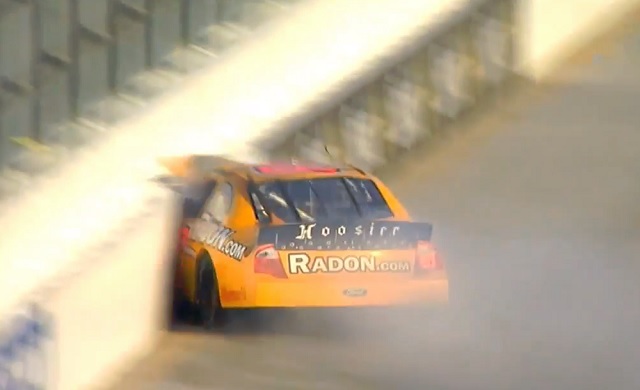May 01, 2015
Deforming
There was a nasty wreck during the ARCA series race at Talladega today. Austin Self got a little squirrely and spun in the tri-oval, not an uncommon occurrence. As his car flailed around, it caught the hard-charging car of Brad Smith right in the nose. Along with the obvious damage, Smith's throttle was stuck open. He went up the track, smacked the outside wall, and then...
Rescue crews actually had to cut Smith from the wreckage of the car, but he was able to walk under his own power to the ambulance, though unsteadily. Taken to the infield care unit, he was later helicoptered to the nearby University of Alabama-Birmingham Hospital for further observation.
I mention all this because of a screenshot I saw of the wreck... to whit, this one:

The particular stretch of wall that Smith impacted had what's called a SAFER (Steel And Foam Energy Reduction) Barrier installed in front of it. When hit, it's designed to crumple like a beercan, reducing the strength of the impact before the car makes contact with the concrete wall behind it. That's why Smith's car looks like it's smooshed to half its size: part of it is inside the SAFER barrier.
During the NASCAR Xfinity race at Daytona back in February Kyle Busch had a similar accident, except the wall he hit notably didn't have the SAFER barriers installed. He suffered a broken right leg and left foot. Certainly there were differences: impact angle, size and weight of the cars, so on and so forth... but that one man could walk away and the other is sidelined and will remain so for an unknown amount of time may very well come down to the way the wall deformed.
F1 doesn't use SAFER barriers; instead, they use tire walls which really do much the same thing, or TECPRO barriers at four or five circuits. TECPRO is the same idea as SAFER, just with much more foam and less steel. It's used mostly at Monaco, where it protected Sergio Perez from what would have been a catastrophic injury in 2011. Compare that accident to Jenson Button's in 2003, when they had a tire wall instead... no give at all.
In most cases for F1, tire barriers are sufficient. Walls are usually far away from the track, and when they're not, a car isn't likely to hit them (on straightaways, for example). Tire barriers are "good enough" in those circumstances, combined with the way F1 cars are designed to absorb impacts. A SAFER barrier might actually hinder the way a F1 car takes damage, come to think of it.
Well, there you go.
Rescue crews actually had to cut Smith from the wreckage of the car, but he was able to walk under his own power to the ambulance, though unsteadily. Taken to the infield care unit, he was later helicoptered to the nearby University of Alabama-Birmingham Hospital for further observation.
I mention all this because of a screenshot I saw of the wreck... to whit, this one:

The particular stretch of wall that Smith impacted had what's called a SAFER (Steel And Foam Energy Reduction) Barrier installed in front of it. When hit, it's designed to crumple like a beercan, reducing the strength of the impact before the car makes contact with the concrete wall behind it. That's why Smith's car looks like it's smooshed to half its size: part of it is inside the SAFER barrier.
During the NASCAR Xfinity race at Daytona back in February Kyle Busch had a similar accident, except the wall he hit notably didn't have the SAFER barriers installed. He suffered a broken right leg and left foot. Certainly there were differences: impact angle, size and weight of the cars, so on and so forth... but that one man could walk away and the other is sidelined and will remain so for an unknown amount of time may very well come down to the way the wall deformed.
F1 doesn't use SAFER barriers; instead, they use tire walls which really do much the same thing, or TECPRO barriers at four or five circuits. TECPRO is the same idea as SAFER, just with much more foam and less steel. It's used mostly at Monaco, where it protected Sergio Perez from what would have been a catastrophic injury in 2011. Compare that accident to Jenson Button's in 2003, when they had a tire wall instead... no give at all.
In most cases for F1, tire barriers are sufficient. Walls are usually far away from the track, and when they're not, a car isn't likely to hit them (on straightaways, for example). Tire barriers are "good enough" in those circumstances, combined with the way F1 cars are designed to absorb impacts. A SAFER barrier might actually hinder the way a F1 car takes damage, come to think of it.
Well, there you go.
Posted by: Wonderduck at
11:58 PM
| Comments (9)
| Add Comment
Post contains 441 words, total size 3 kb.
27kb generated in CPU 0.0266, elapsed 1.0301 seconds.
46 queries taking 1.0228 seconds, 283 records returned.
Powered by Minx 1.1.6c-pink.
46 queries taking 1.0228 seconds, 283 records returned.
Powered by Minx 1.1.6c-pink.









